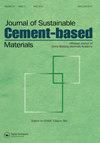量化不同环境条件下AAC砌块的体积变化
IF 4.2
3区 工程技术
Q1 CONSTRUCTION & BUILDING TECHNOLOGY
Journal of Sustainable Cement-Based Materials
Pub Date : 2023-04-13
DOI:10.1080/21650373.2023.2196793
引用次数: 0
摘要
蒸压加气混凝土(AAC)砌体系统被广泛用作框架结构中的隔墙。这种墙体在施工一定时间后经常出现裂缝。砌体系统在不同温度和相对湿度(RH)条件下发生的尺寸变化是造成这种痛苦的一些主要原因。过去的研究表明,垫层砂浆会因收缩行为而显著导致尺寸变化。大多数文献都集中在描述原材料对AAC块的微观结构、强度和性能特征的影响。在目前的研究中,在受控和周围环境条件下对有和没有垫层砂浆的AAC砌块进行了实验研究,以了解温度和相对湿度对这些墙体系统尺寸变化行为的影响。此外,将AAC砖观察到的尺寸变化与传统粘土砖和粉煤灰砖进行了比较,以了解这些材料的内在特性。在环境条件下的实验研究中,建造了小型和大型AAC砌体单元,并在一个月内监测其尺寸变化。结果表明,AAC砌块随垫层砂浆的变化而发生显著的尺寸变化,这在很大程度上受到砌体系统边界条件、相对湿度和温度的影响。最后,在构件和系统层面提出了减少AAC砌体裂缝发展的建议。本文章由计算机程序翻译,如有差异,请以英文原文为准。
Quantification of volume change of AAC blocks for various environmental conditions
Autoclaved Aerated Concrete (AAC) masonry systems are widely used as partition walls in framed structures. Cracking is often reported in such walls after a certain duration of construction. Dimensional changes occurring in the masonry system under varying temperature and relative humidity (RH) conditions are some of the primary reasons for such distress. Past studies show that bedding mortar can significantly contribute to dimensional changes due to shrinkage behaviour. Most of the literature focus on characterising the influence of raw materials on the microstructure, strength, and performance characteristics of AAC blocks. In the current study, experimental studies on AAC blocks with and without bedding mortars are conducted under controlled and ambient environmental conditions to understand the impact of temperature and RH on the dimensional change behaviour of these wall systems. Furthermore, the dimensional changes observed for AAC blocks are compared with conventional clay and fly ash bricks to understand the intrinsic properties of these materials. In the experimental studies under ambient conditions, small and large-scale AAC masonry units are built and monitored for dimensional change over a period of one month. Results show that the AAC block undergoes significant dimensional change along with the bedding mortar, which is greatly influenced by the boundary conditions of the masonry system, relative humidity, and temperature. In the end, recommendations are given at the component and system levels to reduce the crack development in AAC masonry.
求助全文
通过发布文献求助,成功后即可免费获取论文全文。
去求助
来源期刊
CiteScore
6.60
自引率
15.90%
发文量
71
期刊介绍:
The Journal of Sustainable Cement-Based Materials aims to publish theoretical and applied researches on materials, products and structures that incorporate cement. The journal is a forum for discussion of research on manufacture, hydration and performance of cement-based materials; novel experimental techniques; the latest analytical and modelling methods; the examination and the diagnosis of real cement and concrete structures; and the potential for improved cement-based materials. The journal welcomes original research papers, major reviews, rapid communications and selected conference papers. The Journal of Sustainable Cement-Based Materials covers a wide range of topics within its subject category, including but are not limited to: • raw materials and manufacture of cement • mixing, rheology and hydration • admixtures • structural characteristics and performance of cement-based materials • characterisation techniques and modeling • use of fibre in cement based-materials • degradation and repair of cement-based materials • novel testing techniques and applications • waste management

 求助内容:
求助内容: 应助结果提醒方式:
应助结果提醒方式:


